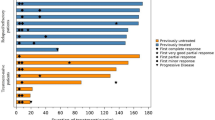Abstract
In the present study we investigated the long-term effect of intravenous pulse cyclophosphamide (CY) on lymphocyte surface antigens in systemic lupus erythematosus (SLE) patients. Blood samples derived from 17 lupus erythematosus patients were analysed using two- and three-colour flow cytometry. During the CY therapy, the total number of T lymphocytes (CD3+) was reduced by 31.4%, B lymphocytes (CD19+) by 67.4% and NK cells (CD16+) by 27.4%. Six months after the end of the CY regimen, these values recovered to entry levels. At the onset of the study we observed increased percentages of CD3+ CD25+, CD3+ CD4– CD8–, CD4+ CD29+, CD19+ and CD19+ CD5+ cells. The CY treatment regimen decreased the CD3+ CD25+, CD3+ CD4– CD8–, CD19+ and CD19+ CD5+ cells, but increased the CD3+ CD8+ subpopulation. Taken together, a deficiency of CD8+ T cells associated with CD4+ CD29+ predominance may imply an immune regulatory imbalance leading to abnormal CD4+ cell activation and in consequence to autoimmunity. Depletion of CD19+ cells combined with an enlargement of CD8 cells as a result of CY therapy may reduce the enhanced immune response in SLE patients.
Similar content being viewed by others
Author information
Authors and Affiliations
Additional information
Received: 13 December 1996 / Accepted: 10 March 1997
Rights and permissions
About this article
Cite this article
Lacki, J., Mackiewicz, S., Leszczynski, P. et al. The effect of intravenous cyclophosphamide pulse on peripheral blood lymphocytes in lupus erythematosus patients. Rheumatology International 17, 55–60 (1997). https://doi.org/10.1007/PL00006852
Issue Date:
DOI: https://doi.org/10.1007/PL00006852




